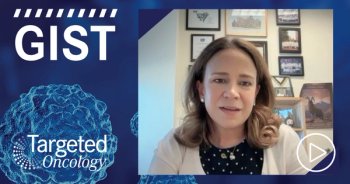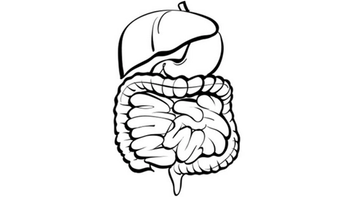
Treatment Options in Gastrointestinal Stromal Tumors
Neeta Somaiah, MD: After frontline therapy, what are the approved or available lines of therapy in the second line? Approved therapy for second-line treatment of GIST [gastrointestinal stromal tumor], it’s sunitinib, which was approved based on a randomized, placebo-controlled trial. When patients are progressing on imatinib, it’s important to recognize the types of progression.
Occasionally patients who’ve had a good response to imatinib, if they’ve had a KIT or one of the sensitive PDGFR mutations, they’re responding well, they develop very cystic lesions, and then over time within these lesions you might start seeing what we call nodular progression, or small nodules of solid tumor that start appearing and slowly growing over time. What that signifies is that there is probably development of a resistance mutation in a little clone of cells that is now growing.
The second type of progression of course is when you have more global progression in multiple tumors or multiple metastases all at the same time, and it’s not nodular. These tend to be either primary resistance patterns, where the patient never responded to imatinib and continued to progress, or they were responding, but then multiple lesions started to progress.
The type of progression tends to point toward the type of resistance the patient might have to the treatment. If you have more global progression, it points to either a resistant mutation up front like the PDGFR D842V. Sometimes these patients might have NF1 [neurofibromatosis type 1], some of these wild-type tumors, some mutations that don’t respond to imatinib might have more of a global progression.
In patients who were responding and develop multiple areas that are progressing, it signifies secondary mutations that might have developed after the primary mutation. Nodular progression usually signifies a secondary mutation that has developed on top of the primary KIT or PDGFR mutation.
What are secondary mutations that are common? I said that 60% to 70% have a KIT primary mutation, and they’re most common in exon 11 and exon 9. Primary mutations in exon 13, 14, and 17 are very rare, it’s just 1%. When you look at secondary mutations, and this again, not everybody gets this evaluated because not everybody gets a biopsy at the time of progression, but if you do a biopsy of the progressing lesion, you might find in addition to their primary mutation that they now have a mutation in exon 13, or exon 17 and 18. These tend to be the more common secondary mutations.
The type of secondary mutation also points sometimes to whether you would respond to a certain second-line therapy. In the second-line treatment, sunitinib is the standard, unless you have an available clinical trial to offer in the second line. If you do have secondary mutation data, either from a tumor biopsy or perhaps from circulating tumor cells, what we call liquid biopsy, you could take that into consideration. Though I usually use caution; I like to follow the standard second-line and third-line treatment because sometimes biopsy of 1 tumor site might not represent the secondary mutations that might be present in all of the metastatic sites in the patient.
If you do detect…an exon 13 secondary mutation, sunitinib works well. If you have an exon 17 secondary mutation, sunitinib might not work that well, but you might want to test them a little sooner, keep a closer eye, and not go 3 months before the next scan, but probably do it in a 2-month timeframe.
Transcript edited for clarity.
Case:
A 68-Year-Old Man With Gastrointestinal Stromal Tumor
Initial presentation
- A 68-year-old man complains of a 4-month history of decreased appetite, vague abdominal discomfort and a sensation of fullness
- PMH: DM, medically controlled; colonoscopy at age 50 was unremarkable; no family history of cancer
- PE: abdominal pain on deep palpation; otherwise unremarkable
Clinical workup
- Labs: Hb 10.5 g/dL, plt 105 x 109/L; other lab values WNL
- Endoscopy: showeda submucosal ~6 cm mass with ulceration
- EUS: irregular borders on extraluminal surfaces with marginal halo and hyperechogenic spots
- FNA biopsy: mitotic activity showed >5 mitoses/50 HPFs
- Mutational testing: WT-GIST
- Abdominal/pelvic CT confirmed a 6.2 cm lesion with indistinct margins in the body of the stomach
- MRI showed 3 small hepatic lesions consistent with metastases
- Stage IV; ECOG 0
Treatment
- He was started on imatinib 400 mg PO qDay, continued for 24 months until he complained of increased abdominal pain and an additional 8-lb weight loss
- ECOG 1; Imatinib was discontinued
- Treatment initiated with sunitinib 50 mg PO qDay for 4 weeks, with a 2-week drug-free interval
- Treatment was well tolerated for 3 cycles when he developed nausea and vomiting; dose reduced to 25 mg PO qDay without resolution of AEs; sunitinib was discontinued
- Regorafenib 160 mg (four 40 mg tablets) PO qDay for the first 21 days of each 28-day cycle was started, poorly tolerated
- Repeat lab work showed: Hb 8.9, AST 65 IU/I; regorafenib was discontinued
- The patient was started on ripretinib 150 mg PO qDay










































